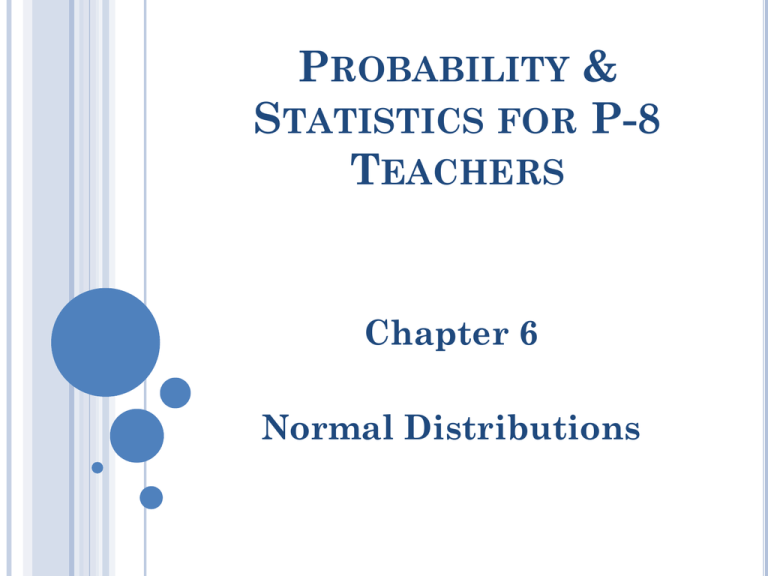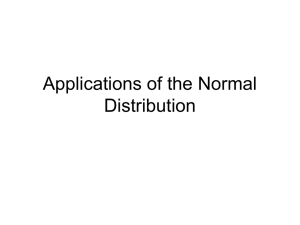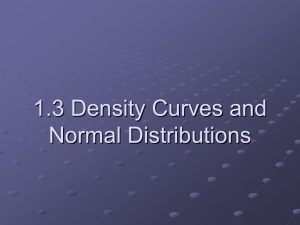Probability & Statistics for P-8 Teachers
advertisement

PROBABILITY & STATISTICS FOR P-8 TEACHERS Chapter 6 Normal Distributions NORMAL DISTRIBUTIONS Many continuous variables have distributions that are bell-shaped and are called approximately normally distributed variables. The theoretical curve, called the bell curve or the Gaussian distribution, can be used to study many variables that are not normally distributed but are approximately normal. NORMAL DISTRIBUTIONS The mathematical equation for the normal distribution is: y e ( X ) 2 ( 2 ) 2 2 w here e 2.718 3.14 population m ean population standard deviation NORMAL DISTRIBUTIONS The shape and position of the normal distribution curve depend on two parameters, the mean and the standard deviation. Each normally distributed variable has its own normal distribution curve, which depends on the values of the variable’s mean and standard deviation. NORMAL DISTRIBUTIONS NORMAL DISTRIBUTION PROPERTIES The normal distribution curve is bell-shaped. The mean, median, and mode are equal and located at the center of the distribution. The normal distribution curve is unimodal (i.e., it has only one mode). The curve is symmetrical about the mean, which is equivalent to saying that its shape is the same on both sides of a vertical line passing through the center. NORMAL DISTRIBUTION PROPERTIES The curve is continuous—i.e., there are no gaps or holes. For each value of X, here is a corresponding value of Y. The curve never touches the x axis. Theoretically, no matter how far in either direction the curve extends, it never meets the x axis—but it gets increasingly closer. NORMAL DISTRIBUTION PROPERTIES The total area under the normal distribution curve is equal to 1.00 or 100%. The area under the normal curve that lies within one standard deviation of the mean is approximately 0.68 (68%). two standard deviations of the mean is approximately 0.95 (95%). three standard deviations of the mean is approximately 0.997 ( 99.7%). EMPIRICAL RULE 68–95–99.7 HOW GOOD IS RULE FOR REAL DATA? Check some example data: The mean of the weight of the women = 127.8 The standard deviation (SD) = 15.5 25 20 P e r c e n t 15 10 5 0 80 90 100 110 120 POUNDS 130 140 150 160 68% of 120 = .68x120 = ~ 82 runners In fact, 79 runners fall within 1-SD (15.5 lbs) of the mean. 112.3 127.8 143.3 25 20 P e r c e n t 15 10 5 0 80 90 100 110 120 POUNDS 130 140 150 160 95% of 120 = .95 x 120 = ~ 114 runners In fact, 115 runners fall within 2-SD’s of the mean. 96.8 127.8 158.8 25 20 P e r c e n t 15 10 5 0 80 90 100 110 120 POUNDS 130 140 150 160 99.7% of 120 = .997 x 120 = 119.6 runners In fact, all 120 runners fall within 3-SD’s of the mean. 81.3 127.8 174.3 25 20 P e r c e n t 15 10 5 0 80 90 100 110 120 POUNDS 130 140 150 160 STANDARD NORMAL DISTRIBUTION Since each normally distributed variable has its own mean and standard deviation, the shape and location of these curves will vary. In practical applications, one would have to have a table of areas under the curve for each variable. To simplify this, statisticians use the standard normal distribution. The standard normal distribution is a normal distribution with a mean of 0 and a standard deviation of 1. AREA AND PROBABILITY Because the total area under the density curve is equal to 1, there is a correspondence between area and probability. Z VALUE (STANDARD VALUE) The z value is the number of standard deviations that a particular X value is away from the mean. The formula for finding the z value is: z value - m ean standard deviation z X STANDARDIZING WITH Z-SCORES Standardized values have no units. z-scores measure the distance of each data value from the mean in standard deviations. negative z-score tells us that the data value is below the mean positive z-score tells us that the data value is above the mean. STANDARDIZING VALUES Standardized values have been converted from their original units to the standard statistical unit of standard deviations from the mean. Thus, we can compare values that are measured on different scales, with different units, or from different populations. STANDARDIZING VALUES Recall z-score: z = (x - µ)/σ AREA UNDER THE STANDARD NORMAL DISTRIBUTION CURVE 1. To the left of any z value: Look up the z value in the table and use the area given. AREA UNDER THE STANDARD NORMAL DISTRIBUTION CURVE 2. To the right of any z value: Look up the z value and subtract the area from 1. AREA UNDER THE STANDARD NORMAL DISTRIBUTION CURVE 3. Between two z values: Look up both z values and subtract the corresponding areas. AREA UNDER THE CURVE Find the area to the left of z = 1.99. The value in the 1.9 row and the .09 column of Table E is .9767. The area is .9767 AREA UNDER THE CURVE Find the area to right of z = -1.16. The value in the -1.1 row and the .06 column of Table E is .1230. The area is 1 - .1230 = .8770 AREA UNDER THE CURVE Find the area between z = 1.68 and z = -1.37. The values for z = 1.68 is .9535 and for z = -1.37 is .0853. The area is .9535 - .0853 = .8682 PROBABILITY a. Find the probability: P(0 < z < 2.32) The values for z = 2.32 is .9898 and for z = 0 is .5000. The probability is .9898 - .5000 = .4898 PROBABILITY Find the z value such that the area under the standard normal distribution curve between 0 and the z value is 0.2123. Add .5000 to .2123 to get the cumulative area of .7123. Then look for that value inside Table E. PROBABILITY Add .5000 to .2123 to get the cumulative area of .7123. Then look for that value inside Table E. The z value is 0.56. HELPFUL HINTS Don’t confuse z-scores and areas. z-scores are distances along the horizontal scale, but areas are regions under the normal curve. z-scores are in the left column and across the top row, but areas are found in the body of the table. Choose the correct (right/left) side of the graph. A z-score must be negative whenever it is located in the left half of the normal distribution. Areas (or probabilities) are positive or zero values, but they are never negative. APPLICATIONS OF THE NORMAL DISTRIBUTIONS The standard normal distribution curve can be used to solve a wide variety of practical problems. The only requirement is that the variable be normally or approximately normally distributed. For all the problems presented in this chapter, you can assume that the variable is normally or approximately normally distributed. APPLICATIONS OF THE NORMAL DISTRIBUTIONS To solve problems by using the standard normal distribution, transform the original variable to a standard normal distribution variable by using the z value formula. This formula transforms the values of the variable into standard units or z values. Once the variable is transformed, then the Procedure Table and Table E in Appendix C can be used to solve problems. FINDING PROBABILITIES FOR NORMAL DISTRIBUTIONS A survey indicates that people use their computers an average of 2.4 years before upgrading to a new machine. The standard deviation is 0.5 year. A computer owner is selected at random. Find the probability that he or she will use it for fewer than 2 years before upgrading. Assume that the variable x is normally distributed. FINDING PROBABILITIES FOR NORMAL DISTRIBUTIONS Step 1: Draw the normal distribution curve. μ = 2.4 σ = 0.5 P(x < 2) x 2 2.4 FINDING PROBABILITIES FOR NORMAL DISTRIBUTIONS Step 2: Find the z-score corresponding to 2 years z x 2 2.4 0.5 0.80 FINDING PROBABILITIES FOR NORMAL DISTRIBUTIONS Step 3: Find the area to the left of z = -0.80 Table E indicates area = 0.2119 P(x < 2) = P(z < -0.80) = 0.2119 0.2119 z -0.80 0 APPLICATIONS Intelligence quotients (IQs) measured on the Stanford Revision of the Binet-Simon Intelligence Scale are normally distributed with a mean of 100 and a standard deviation of 16. Determine the percentage of people who have IQs between 115 and 140. Step 1: Sketch the normal curve associated with the variable. APPLICATIONS Step 2: Compute z-scores: x = 115 z = (115–100)/16 = 0.94 x = 140 z = (140–110)/16 = 2.50 Step 3: The area to the left of 0.94 is 0.8264 The area to the left of 2.50 is 0.9938. The shaded area is therefore 0.9938 −0.8264 = 0.1674. 16.74% of all people have IQs between 115 and 140. APPLICATIONS To qualify for a police academy, candidates must score in the top 10% on a general abilities test. The test has a mean of 200 and a standard deviation of 20. Find the lowest possible score to qualify. Assume the test scores are normally distributed. Step 1: Draw the normal distribution curve. APPLICATIONS Step 2: Subtract 1 - 0.1000 to find area to the left, 0.9000. Look for the closest value to that in Table E. Step 3: Find X. X z 2 0 0 1 .2 8 2 0 2 2 5 .6 0 The cutoff, the lowest possible score to qualify, is 226. APPLICATIONS To transform a standard z-score to a data value x in a given population, use the formula x = μ + zσ Step 3: Find X. X z 2 0 0 1 .2 8 2 0 2 2 5 .6 0 The cutoff, the lowest possible score to qualify, is 226. 226 THE CENTRAL LIMIT THEOREM In addition to knowing how individual data values vary about the mean for a population, statisticians are interested in knowing how the means of samples of the same size taken from the same population vary about the population mean. DISTRIBUTION OF SAMPLE MEANS A sampling distribution of sample means is a distribution obtained by using the means computed from random samples of a specific size taken from a population. Sampling error is the difference between the sample measure and the corresponding population measure due to the fact that the sample is not a perfect representation of the population. PROPERTIES OF THE DISTRIBUTION OF SAMPLE MEANS The mean of the sample means will be the same as the population mean. The standard deviation of the sample means will be smaller than the standard deviation of the population, and will be equal to the population standard deviation divided by the square root of the sample size. THE CENTRAL LIMIT THEOREM As the sample size n increases, the shape of the distribution of the sample means taken with replacement from a population with mean and standard deviation will approach a normal distribution. The mean of the sample means equals the population mean. X . The standard deviation of the sample means is called the standard error of the mean. X n. THE CENTRAL LIMIT THEOREM The central limit theorem can be used to answer questions about sample means in the same manner that the normal distribution can be used to answer questions about individual values. A new formula must be used for the z values: z X X X X n APPLICATIONS (CLT) A. C. Neilsen reported that children between the ages of 2 and 5 watch an average of 25 hours of television per week. Assume the variable is normally distributed and the standard deviation is 3 hours. If 20 children between the ages of 2 and 5 are randomly selected, find the probability that the mean of the number of hours they watch television will be greater than 26.3 hours. APPLICATIONS (CLT) Since we are calculating probability for a sample mean, we need the Central Limit Theorem formula z X n 2 6 .3 2 5 3 1 .9 4 20 The area is 1.0000 – 0.9738 = 0.0262. The probability of obtaining a sample mean larger than 26.3 hours is 2.62%. APPLICATIONS (CLT) The average age of a vehicle registered in the United States is 8 years, or 96 months. Assume the standard deviation is 16 months. If a random sample of 36 vehicles is selected, find the probability that the mean of their age is between 90 and 100 months. Since the sample is 30 or larger, the normality assumption is not necessary. APPLICATIONS (CLT) z 90 96 16 36 2 .2 5 z 100 96 16 1 .5 0 36 Table E gives us areas 0.9332 and 0.0122, respectively. The desired area is 0.9332 - 0.0122 = 0.9210. The probability of obtaining a sample mean between 90 and 100 months is 92.1%. APPLICATIONS (CLT) The average number of pounds of meat that a person consumes per year is 218.4 pounds. Assume that the standard deviation is 25 pounds and the distribution is approximately normal. a. Find the probability that a person selected at random consumes less than 224 pounds per year. APPLICATIONS (CLT) z X 224 218.4 0.22 25 The area to the left of z = 0.22 is 0.5871. Hence, the probability of selecting an individual who consumes less than 224 pounds of meat per year is 0.5871, or 58.71%. APPLICATIONS (CLT) The average number of pounds of meat that a person consumes per year is 218.4 pounds. Assume that the standard deviation is 25 pounds and the distribution is approximately normal. b. If a sample of 40 individuals is selected, find the probability the sample will be less than 224 pounds per year. APPLICATIONS (CLT) z X n 2 2 4 2 1 8 .4 25 1 .4 2 40 The area to the left of z = 1.42 is 0.9222. Hence, the probability that the mean of a sample of 40 individuals is less than 224 pounds per year is 0.9222, or 92.22%. THE NORMAL APPROXIMATION TO THE BINOMIAL DISTRIBUTION A normal distribution is often used to solve problems that involve the binomial distribution since when n is large (say, 100), the calculations are too difficult to do by hand using the binomial distribution. THE NORMAL APPROXIMATION TO THE BINOMIAL DISTRIBUTION The normal approximation to the binomial is appropriate when np > 5 and nq > 5 . In addition, a correction for continuity may be used in the normal approximation to the binomial. The continuity correction means that for any specific value of X, say 8, the boundaries of X in the binomial distribution (in this case, 7.5 to 8.5) must be used. THE NORMAL APPROXIMATION TO THE BINOMIAL DISTRIBUTION Binomial Normal When finding: P(X = a) P(X a) P(X > a) P(X a) P(X < a) Use: P(a – 0.5 < X < a + 0.5) P(X > a – 0.5) P(X > a + 0.5) P(X < a + 0.5) P(X < a – 0.5) F o r all cases, n p , n p q , n p 5, n q 5 THE NORMAL APPROXIMATION TO THE BINOMIAL DISTRIBUTION Procedure Table Step 1: Check to see whether the normal approximation can be used. Step 2: Find the mean µ and the standard deviation . Step 3: Write the problem in probability notation, using X. Step 4: Rewrite the problem by using the continuity correction factor, and show the corresponding area under the normal distribution. Step 5: Find the corresponding z values. Step 6: Find the solution. BINOMIAL APPROXIMATION A magazine reported that 6% of American drivers read the newspaper while driving. If 300 drivers are selected at random, find the probability that exactly 25 say they read the newspaper while driving. Here, p = 0.06, q = 0.94, and n = 300. Step 1: Check to see whether a normal approximation can be used. np = (300)(0.06) = 18 and nq = (300)(0.94) = 282 Since np 5 and nq 5, we can use the normal distribution. Step 2: Find the mean and standard deviation. µ = np = (300)(0.06) = 18 npq 3 0 0 0 .0 6 0 .9 4 4 .1 1 BINOMIAL APPROXIMATION Step 3: Write in probability notation. P(X = 25) Step 4: Rewrite using the continuity correction factor. P(24.5 < X < 25.5) Step 5: Find the corresponding z values. z 24.5 18 1.58, 4.11 z 25.5 18 1.82 4.11 Step 6: Find the solution The area between the two z values is = 0.0227, or 2.27%. 0.9656 - 0.9429 Hence, the probability that exactly 25 people read the newspaper while driving is 2.27%. BINOMIAL APPROXIMATION Of the members of a bowling league, 10% are widowed. If 200 bowling league members are selected at random, find the probability that 10 or more will be widowed. Here, p = 0.10, q = 0.90, and n = 200. Step 1: Check to see whether a normal approximation can be used. np = (200)(0.10) = 20 and nq = (200)(0.90) = 180 Since np 5 and nq 5, we can use the normal distribution. Step 2: Find the mean and standard deviation. µ = np = (200)(0.06) = 20 npq 200 0.10 0.90 4.24 BINOMIAL APPROXIMATION Step 3: Write in probability notation. P(X 10) Step 4: Rewrite using the continuity correction factor. P(X > 9.5) Step 5: Find the corresponding z values. z 9.5 20 2.48 4.24 Step 6: Find the solution The area to the right of the z value is 0.9934, or 99.34%. 1.0000 - 0.0066 = The probability of 10 or more widowed people in a random sample of 200 bowling league members is 99.34%.







